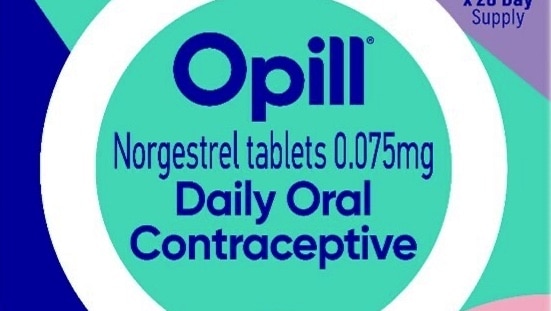Post-Roe America: How OTC Birth Control Changes The Landscape

Table of Contents
Increased Access and Affordability
The landmark shift towards over-the-counter birth control offers a crucial pathway to improved reproductive healthcare access. For many, obtaining reliable contraception has historically been fraught with obstacles.
Breaking Down Barriers to Contraception
Prior to the increased availability of OTC birth control, accessing contraception presented significant hurdles, particularly for low-income women and those in rural areas.
- High cost of prescription birth control: Prescription birth control methods, even with insurance, can be expensive, creating a significant financial barrier for many.
- Lack of insurance coverage: Many insurance plans have limited coverage for contraception, leaving individuals with substantial out-of-pocket costs.
- Inconvenient clinic locations: Accessing healthcare providers, especially in rural areas, often requires significant travel time and expense.
- Long wait times for appointments: Scheduling appointments with doctors or clinics can be time-consuming and inconvenient, delaying access to necessary contraception.
Over-the-counter birth control significantly mitigates these barriers. The elimination of doctor visits and prescriptions makes birth control readily available and considerably more affordable. This increased accessibility empowers individuals to take control of their reproductive health without the constraints of cost or logistical challenges. For example, studies show that the cost of a year's supply of certain prescription birth control pills can exceed $1000, while OTC options may cost significantly less. This difference can be pivotal for individuals struggling financially.
Empowering Individuals to Manage their Reproductive Health
Easy access to OTC birth control empowers individuals to manage their reproductive health with greater autonomy.
- Increased control over family planning: Individuals can make timely decisions about contraception without needing to schedule appointments or navigate insurance complexities.
- Reduced reliance on healthcare providers for contraception: This reduces the dependence on potentially overburdened healthcare systems, freeing up resources for other vital health services.
- Ability to discreetly purchase and use birth control: The ability to purchase contraception privately reduces potential stigma and discomfort associated with seeking healthcare services.
This increased control significantly impacts an individual's psychological well-being, fostering a sense of empowerment and agency over their reproductive life. Furthermore, easier access can lead to improved adherence to birth control regimens, which directly contributes to greater effectiveness in preventing unintended pregnancies.
Potential Impacts on Unintended Pregnancies and Abortion Rates
The wider availability of OTC birth control has the potential to significantly influence both unintended pregnancy rates and abortion rates.
Preventing Unintended Pregnancies
Increased access to OTC birth control is expected to lead to a reduction in unintended pregnancies through several mechanisms:
- Increased contraceptive use: More readily available and affordable birth control will likely lead to higher rates of consistent use among those who previously faced barriers to access.
- Improved adherence: Easier access means that individuals are more likely to maintain consistent use, thereby reducing the risk of pregnancy.
- Earlier access to effective birth control methods: Young people, in particular, can gain quicker access to effective methods, significantly reducing the risk of early unintended pregnancy.
Numerous studies have demonstrated a strong correlation between increased access to contraception and decreased rates of unintended pregnancy. By making contraception more readily available, OTC birth control offers a powerful preventative measure.
The Complex Relationship between Contraception and Abortion Access
While increased access to contraception has the potential to significantly reduce the number of abortions, it's crucial to acknowledge that it doesn't eliminate the need for abortion services entirely.
- Cases of contraceptive failure: All methods of birth control have a failure rate, meaning unintended pregnancies can still occur despite consistent use.
- Medical emergencies: Certain medical conditions might necessitate an abortion, regardless of contraceptive use.
- Cases of rape or incest: In cases of sexual assault, access to abortion remains critical.
It's important to understand that birth control and abortion are not mutually exclusive. Comprehensive reproductive healthcare requires access to both effective contraception and safe, legal abortion services.
Challenges and Concerns Surrounding OTC Birth Control
While the expansion of OTC birth control offers significant benefits, several challenges and concerns warrant attention.
Misinformation and Lack of Education
The increased availability of OTC birth control necessitates robust public health initiatives focused on education and accurate information:
- Importance of proper education and counseling: Individuals need clear, accurate information on how to use each method correctly to maximize its effectiveness.
- The need for clear and accessible information on the effectiveness and side effects of different methods: This information must be readily available and easily understandable.
Public health campaigns, educational materials, and healthcare provider training are vital in ensuring that individuals can make informed choices about which OTC birth control option is best for them.
Potential for Increased Health Disparities
The shift to OTC birth control must be managed carefully to avoid exacerbating existing health disparities:
- Unequal access based on socioeconomic status: Low-income individuals might still face financial barriers to purchasing OTC birth control, even if it is more affordable than prescription options.
- Geographic location: Access to OTC birth control might be limited in certain rural or underserved areas.
- Race and ethnicity: Existing racial and ethnic disparities in healthcare access could also influence the equitable distribution of OTC birth control.
Proactive measures are necessary to ensure that all populations, regardless of their socioeconomic status, geographic location, or ethnicity, have equal access to OTC birth control and the education needed to use it effectively.
Conclusion
The increased availability of over-the-counter birth control in a post-Roe America presents a complex but potentially transformative shift. While offering significant potential for increased access, affordability, and individual autonomy in reproductive healthcare, challenges remain regarding education, misinformation, and ensuring equitable access for all. The ultimate impact on unintended pregnancies and abortion rates will depend on a multifaceted approach encompassing widespread education, affordable access, and the proactive addressing of systemic inequalities. To ensure comprehensive reproductive healthcare for all, continued discussion and advocacy around the benefits and challenges of over-the-counter birth control are crucial. Understanding the implications of OTC birth control is essential for navigating this new landscape and shaping a future where everyone has the power to make informed choices about their reproductive health. Let's work together to ensure equitable access to effective over-the-counter birth control for all.

Featured Posts
-
 La Seine Musicale Concerts Danse Cinema Et Spectacles Pour Jeunes Publics 2025 2026
May 04, 2025
La Seine Musicale Concerts Danse Cinema Et Spectacles Pour Jeunes Publics 2025 2026
May 04, 2025 -
 Buduschee Franko Alzhirskikh Otnosheniy Vliyanie Pozitsii Makrona Po Ukraine
May 04, 2025
Buduschee Franko Alzhirskikh Otnosheniy Vliyanie Pozitsii Makrona Po Ukraine
May 04, 2025 -
 Will Cusma Survive Carney And Trumps Upcoming Meeting
May 04, 2025
Will Cusma Survive Carney And Trumps Upcoming Meeting
May 04, 2025 -
 Ofitsialno Dzhidzhi Khadid Podtverdila Roman S Kuperom
May 04, 2025
Ofitsialno Dzhidzhi Khadid Podtverdila Roman S Kuperom
May 04, 2025 -
 Reaction Emue D Emmanuel Macron Rencontre Poignante Avec Des Victimes De L Armee Israelienne
May 04, 2025
Reaction Emue D Emmanuel Macron Rencontre Poignante Avec Des Victimes De L Armee Israelienne
May 04, 2025
